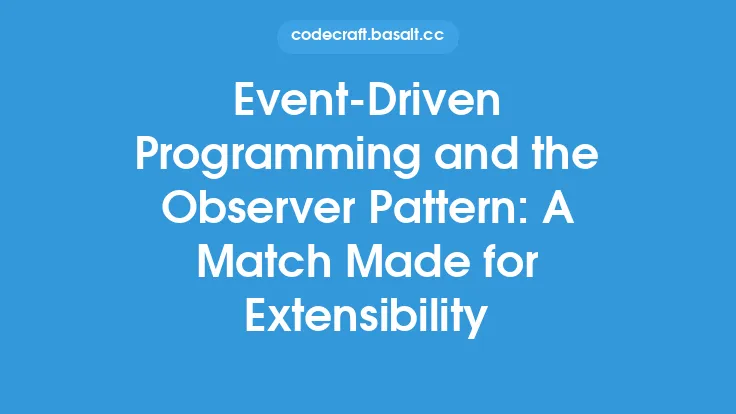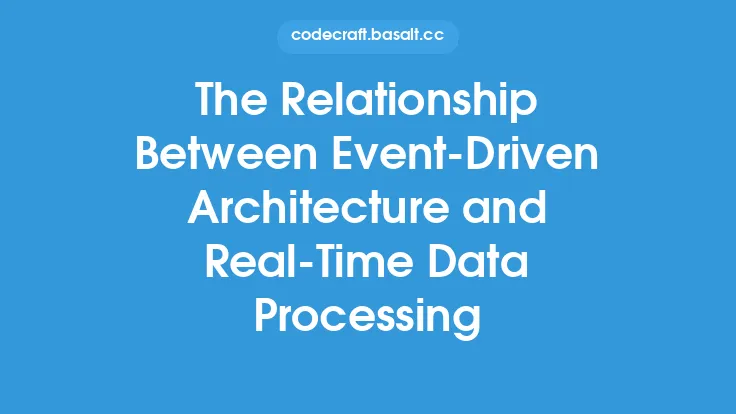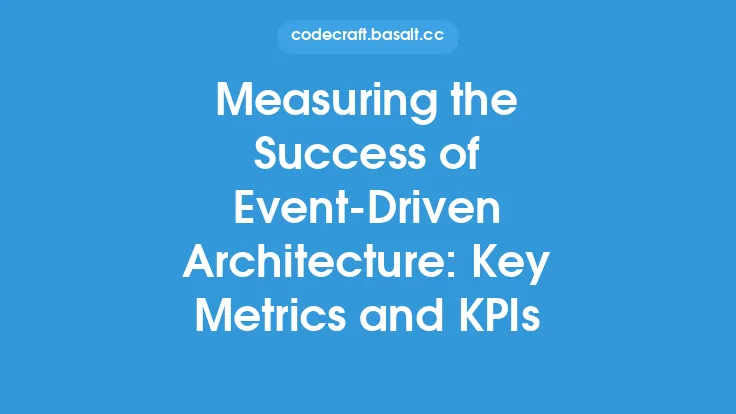Event-driven architecture (EDA) has become a popular approach to designing scalable and flexible software systems. At its core, EDA is centered around the production, detection, and consumption of events, which are significant changes in state or important milestones in a system. One pattern that is particularly well-suited to EDA is the publish-subscribe (pub-sub) pattern, which allows for loose coupling and scalability in event-driven systems. In this article, we will explore the pub-sub pattern and its relationship to event-driven architecture, and discuss how they can be used together to create robust and efficient software systems.
Introduction to the Pub-Sub Pattern
The pub-sub pattern is a messaging paradigm in which publishers send messages to a topic or channel, and subscribers listen to these topics or channels to receive the messages. This pattern allows for loose coupling between the publishers and subscribers, as they do not need to know about each other's existence. The pub-sub pattern is often used in event-driven systems, where events are published to a topic or channel, and subscribers can react to these events as needed. The pub-sub pattern provides a number of benefits, including scalability, flexibility, and fault tolerance, making it a popular choice for event-driven architecture.
How the Pub-Sub Pattern Works
In a pub-sub system, there are three main components: publishers, subscribers, and a message broker. The message broker is responsible for managing the topics or channels, and routing messages from publishers to subscribers. Publishers send messages to the message broker, which then forwards these messages to all subscribers who are listening to the relevant topic or channel. Subscribers can subscribe to multiple topics or channels, and can also unsubscribe as needed. The message broker can be a centralized component, or it can be distributed across multiple nodes to provide scalability and fault tolerance.
Benefits of the Pub-Sub Pattern in Event-Driven Architecture
The pub-sub pattern provides a number of benefits when used in event-driven architecture. One of the main benefits is loose coupling, which allows publishers and subscribers to be developed and deployed independently. This makes it easier to add new subscribers or publishers to the system, without affecting existing components. The pub-sub pattern also provides scalability, as new subscribers can be added as needed, without affecting the publishers. Additionally, the pub-sub pattern provides fault tolerance, as subscribers can continue to operate even if one or more publishers are unavailable.
Use Cases for the Pub-Sub Pattern in Event-Driven Architecture
The pub-sub pattern is well-suited to a number of use cases in event-driven architecture. One common use case is in real-time analytics, where events are published to a topic or channel, and subscribers can react to these events in real-time. Another use case is in IoT systems, where devices publish events to a topic or channel, and subscribers can react to these events to perform actions such as turning on lights or adjusting temperature. The pub-sub pattern is also used in financial systems, where events such as stock trades or transactions are published to a topic or channel, and subscribers can react to these events to perform actions such as updating portfolios or triggering alerts.
Implementing the Pub-Sub Pattern in Event-Driven Architecture
Implementing the pub-sub pattern in event-driven architecture requires a number of components, including a message broker, publishers, and subscribers. The message broker can be a commercial product such as Apache Kafka or Amazon SQS, or it can be a custom-built component. Publishers and subscribers can be developed using a programming language such as Java or Python, and can use APIs or libraries to interact with the message broker. In addition to the technical components, implementing the pub-sub pattern also requires careful consideration of factors such as scalability, fault tolerance, and security.
Best Practices for Using the Pub-Sub Pattern in Event-Driven Architecture
There are a number of best practices to keep in mind when using the pub-sub pattern in event-driven architecture. One best practice is to use a standardized messaging format, such as JSON or Avro, to ensure that messages can be easily consumed by subscribers. Another best practice is to use a message broker that provides scalability and fault tolerance, such as a distributed message broker. Additionally, it is a good idea to implement retry mechanisms and error handling, to ensure that messages are not lost in case of failures. Finally, it is a good idea to monitor and log messages, to ensure that the system is operating correctly and to detect any issues.
Common Challenges and Pitfalls
While the pub-sub pattern is a powerful tool for event-driven architecture, there are a number of common challenges and pitfalls to be aware of. One common challenge is ensuring that messages are delivered reliably, and that subscribers receive all messages that are published. Another challenge is handling failures, such as when a subscriber is unavailable or when a message cannot be delivered. Additionally, the pub-sub pattern can be complex to implement and manage, especially in large-scale systems. To overcome these challenges, it is a good idea to carefully plan and design the system, and to use proven technologies and techniques.
Conclusion
In conclusion, the pub-sub pattern is a powerful tool for event-driven architecture, providing loose coupling, scalability, and fault tolerance. By using a message broker to manage topics or channels, and allowing publishers and subscribers to interact with these topics or channels, the pub-sub pattern makes it easy to build robust and efficient event-driven systems. Whether used in real-time analytics, IoT systems, or financial systems, the pub-sub pattern is a versatile and effective way to handle events and build scalable software systems. By following best practices and being aware of common challenges and pitfalls, developers can use the pub-sub pattern to build event-driven systems that are reliable, efficient, and scalable.





